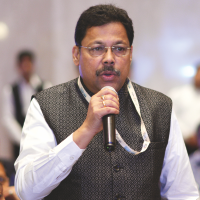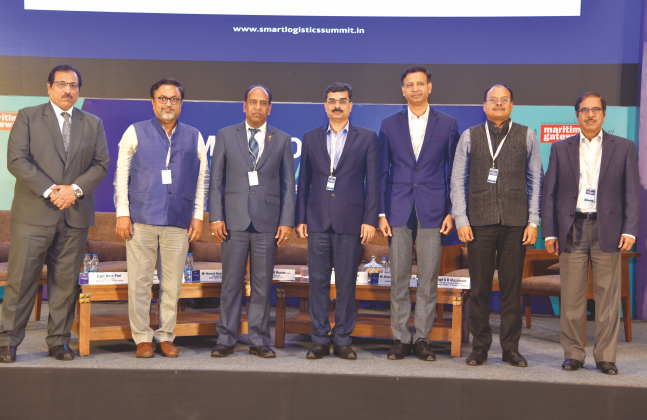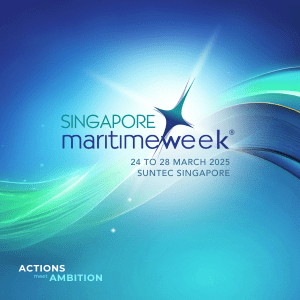Discussions during the session focused on development of inland waterways and how it could connect to neighbouring countries, streamlining documentation to enable shipments move on a single document and developments in the logistics sector in Nepal
The third session began with Shashi Bhushan Shukla, IRS, Member (Traffic), Inland Waterways Authority of India highlighting the progress made in the respective waterways in the country. The National Waterway 1 (NW1), the Ganga- Baghirathi- Hoogly river system starting from Haldia to Allahabad, had been taken up for development with the assistance from the World Bank. It was Rs 5,369 crore project. In the first phase, the waterway was being developed from Haldia to Varanasi along with three multimodal terminals – in Varanasi, Haldia and Sahibganj. Each of these terminals would be connected by road and rail. Containerized movement of cargo had commenced from Varanasi to Haldia. Some of the private players who had shown interest in this mode of transport were, Pepsico, Maersk, Dabur, IFFCO and a few more.
An exclusive container terminal was being built in Kalughat, West Bengal to cater to shipments to and from Nepal. Containers from Kolkata and Haldia Port can come to Kalughat and then move by waterways to Nepal. Likewise Sahibganj could also be used as a terminal for shipments to Nepal. The treaty between India and Nepal needed to be amended to include transportation by inland waterways.
In NW1, an Indo-Bangladesh Protocol route was being developed. From Sunderbans, the waterway would connect the Bangladesh rivers – Jamuna, Meghna and Kushiyara rivers. The NW1 would get connected to the waterway NW2 ie the Brahmaputra river. The Ganga and the Brahmaputra rivers would be connected through the Indo Bangladesh Protocol route. The Barak River in Bangladesh was being dredged with 80 per cent financial assistance from India. Once the project was completed there would be a uniform draft of 2.5 meters from Haldia to Bangladesh along this entire stretch.
Dredging was also being done on the Brahmaputra River from Dhubri to Dibrugarh that would maintain a uniform depth of 2.5 meters. There was a jetty in Dhubri and a multimodal terminal at Guwahati. One additional multimodal terminal was being planned at Jogighopa, Assam. From Varanasi to Dibrugarh, a distance of 3500 kms, there would be seamless waterway with a draft of 2.5 meters. With this the northeastern part of India would be connected to North and Eastern parts of India.
Vivek Kale, Co – Founder and Director of Team Global Logistics Pvt Ltd spoke on the future of logistics. An important requirement was the need to have a uniform contract of carriage that helped shipments to move on a single document. Traditionally the multimodal document was meant for exports out of India. Now efforts were being made that would enable exporters to have a single document for the carriage of goods along the inland waterways, not just in India but outside India also. The multimodal transport document was already under amendment. The ICEGATE system does not have a coastal shipment module, which was also being prepared. The PCS ie Port Community System (PCS) was now being linked to the ICEGATE system. The electronic module of coastal shipping and the Inland Waterway Transport (IWT) needed to be linked to the ICEGATE system. And all these systems were to be linked to the PCS not just in India but with the systems in the neighbouring countries also, he said. This dispensation would ensure seamless movement of cargo within and outside India.
Naresh Kumar Agarwal, Treasurer, Nepal Freight Forwarders Association gave an insight into the developments in the logistic sector in Nepal. He was of the opinion that all these years they have not been able to take the benefit of the logistic sector in India. The traditional gateway port for Nepal was Kolkata. There were problems in documentation. Even though the shipment were of Nepal origin, all the documents had to be processed in India again, despite the fact that the duties were paid in Nepal. Because of this reason they had been forced to move away from Kolkata to Visakhapatnam Port. At Visakhapatnam the shipment moved under Electronic Cargo Tracking System (ECTS). Under this mode of transhipment modality, the container were able to move to ICD Birgunj without presentation of documents to the Indian side. From 15th February similar arrangement was to have been implemented from Kolkata Port also. However till date the system had not been implemented.
The problem arose when the Bills of Lading for import were issued for Kolkata instead of ICD Birgunj. The Nepal government was now making it mandatory for opening Letters of Credit with terms showing as CIF or FOB ICD Birgunj. As far as infrastructure was concerned Nepal had 15 road entry point from the Indian side. They had 4 ICDs of which only one was connected by rail and the other 3 were connected by road. They have plans for 4 Integrated Check Post (ICP). One was already operational at Birgunj. Nepal intended to have CFS in each of their 7 states. Almost 65 per cent of the cargo comes to ICD Birgunj.

Finally the Indian and the Nepalese government had principally agreed to provide Nepal access to the waterways. This would enable Nepal to move cargo through multimodal transport. Agarwal concluded by saying that ECTS and waterways agreement would need to be implemented in the transit treaty between Nepal and India. Capt Nitin Puri, Vice President, MSC Agency (India) Private Limited spoke of the problems they faced at Kolkata port particularly in the winter season when there were draft problems. When such situations arose, they were forced to look for alternate solutions of deploying barges, double banking at Diamond harbour to fill up the vessel. But unfortunately the availability of barges was limited. He was of the opinion that the port should have their own barges to enable shipping lines to deploy them. This would increase throughput for the lines. But despite the problems, the volumes in Kolkata port had risen.
Vinit Kumar IRSEE, Chairman, Kolkata Port Trust felt that the focus had shifted from west to east which was encouraging. Last year they had achieved the highest ever traffic of Kolkata Port Trust and for Kolkata Dock System. And he hoped that this year they would surpass the target. Further he was confident that the Haldia Dock System would also achieve the highest ever cargo handled. They were in talks with PSA for mechanising berth number 3. They were also contemplating to convert one of the jetty to a container or a break-bulk terminal. That would be on a PPP project. On shore, with regard to rail evacuation, they could handle one and half rakes per day. Two additional line were being doubled which were under construction. He hopes that within three months they would have two full rake sidings for loading containers. This would take their number of rakes handled per day to 4. The road conditions were bad two years ago, but now they had a budget of Rs 100 crores for improvement of road infrastructure.
They also had plans to evacuate cargo through waterways. Very soon they expect to have Ro-Ro service from Bhoot Ghat to Sakhrail. The plying vessels would have a capacity of 20 trucks.
For Haldia there was a plan for the mechanisation of one more berth. They were also coming up for liquid facilities – one at outer terminal two and the other Shalukhali. This would increase their liquid capacity by 4 to 5 million metric tons.
In Capt Puri’s opinion the growth in the eastern sector was taking over the growth in the western sector. He also felt that Kolkata and Haldia would be a major player in the movement of NW1.








